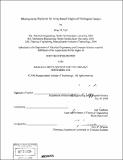| dc.contributor.advisor | Joel Voldman. | en_US |
| dc.contributor.author | Taff, Brian M., 1978- | en_US |
| dc.contributor.other | Massachusetts Institute of Technology. Dept. of Electrical Engineering and Computer Science. | en_US |
| dc.date.accessioned | 2009-06-30T16:31:14Z | |
| dc.date.available | 2009-06-30T16:31:14Z | |
| dc.date.copyright | 2008 | en_US |
| dc.date.issued | 2008 | en_US |
| dc.identifier.uri | http://hdl.handle.net/1721.1/45879 | |
| dc.description | Thesis (Ph. D.)--Massachusetts Institute of Technology, Dept. of Electrical Engineering and Computer Science, 2008. | en_US |
| dc.description | Includes bibliographical references (p. 157-164). | en_US |
| dc.description.abstract | For much of the past century, plated cell cultures have served investigations regarding a variety of fundamental biological processes. Though this in vitro approach has been fruitful, for surveying topics including cell cycle effects3' 8, pro-survival4, 7, 9, 10 and apoptotic2' 11 signaling networks, gene regulationl2' 13, and stress dynamicsl4' 15 (among others), it caters best to harvesting the averaged responses from binned populations of cells and offers only limited avenues for tracking individual cell behaviors. Microsystems-based initiatives16-28 are beginning to aid this investigative shortcoming by offering a variety of strategies for handling individual cells. Such efforts, may ultimately serve studies of cross-population heterogeneity29-33, an effect often masked when tracking responses via averaged population-based means. As it is believed that small subpopulations of cells may be responsible or determining the fate of various diseases and developmental processes34-36, this new paradigm for probing cell function will likely offer key insights.In my dissertation, I offer a unique suite of microsystems-based tools37-42 for servicing novel biological assays centered on cross-population dynamics. This work leverages the investigative potential enabled by arrayed groupings of precisely-spaced single cells and presents innovations in active and passive cell trapping architectures, packaging design, and the use of novel materials for microfabrication41' 43. From proof-of-concept forays, where I discuss the first reported row/column-based electrically-addressable platform40 for trapping, imaging, and releasing collections of individual cells, to scaled implementations that employ frequency modulation to assign unique forcing effects to in-system constructs, I outlay fundamentals for designing, building, and evaluating dielectrophoresis-reliant (DEP) microsystems architectures. | en_US |
| dc.description.abstract | (cont.) I further present matured platforms that, for the first time, parallelize single-cell manipulations within microfluidic devices by combining hydrodynamic weir-based cell capture with DEP-based actuation37-39. In progressions toward functional on-chip bioassays, I experimentally validate conditions for in-device cell viability and offer a novel means for tracking mitosis in individual cells. Ongoing work, related to the developments presented here, offers the hope of new empirical approaches to drug discovery, the assignment of gene function in the aftermath of the human genome project, and enhanced understandings of cell communication-linked dynamic responses. | en_US |
| dc.description.statementofresponsibility | by Brian M. Taff. | en_US |
| dc.format.extent | 164 p. | en_US |
| dc.language.iso | eng | en_US |
| dc.publisher | Massachusetts Institute of Technology | en_US |
| dc.rights | M.I.T. theses are protected by
copyright. They may be viewed from this source for any purpose, but
reproduction or distribution in any format is prohibited without written
permission. See provided URL for inquiries about permission. | en_US |
| dc.rights.uri | http://dspace.mit.edu/handle/1721.1/7582 | en_US |
| dc.subject | Electrical Engineering and Computer Science. | en_US |
| dc.title | Microsystems platforms for array-based single-cell biological assays | en_US |
| dc.type | Thesis | en_US |
| dc.description.degree | Ph.D. | en_US |
| dc.contributor.department | Massachusetts Institute of Technology. Department of Electrical Engineering and Computer Science | |
| dc.identifier.oclc | 320122147 | en_US |
